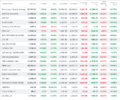bigdog
Retired many years ago
- Joined
- 19 July 2006
- Posts
- 8,215
- Reactions
- 5,655

Asia markets rise, except Japan, ahead of US jobs report
Shares are mostly higher in Asia, led by a 5.8% jump in Hong Kong's Hang Seng index as Chinese markets were lifted by speculation that Beijing might begin to ease pandemic restrictions.
Stocks end lower as the Fed continues to fight inflation
By DAMIAN J. TROISE and ALEX VEIGAStocks racked up more losses on Wall Street and Treasury yields again rose to multiyear highs Thursday as investors looked ahead to a closely watched job market report from the government that could influence the Federal Reserve’s next move in its fight to bring down inflation.
Technology stocks led the market pullback, which came a day after the central bank raised its benchmark rate for the sixth time this year and signaled that it may need to keep hiking rates for some time before its can successfully squash the highest inflation in decades.
The S&P 500 fell 1.1%, while the Dow Jones Industrial Average dropped 0.5%. The tech-heavy Nasdaq composite closed 1.7% lower. The declines extended the major indexes’ losing streak to a fourth day. They’re each on pace for a weekly loss.
Expectations of higher rates helped push up Treasury yields, weighing on stocks. The two-year Treasury note, which tends to track expectations for future Fed moves, rose to 4.72% from 4.61% late Wednesday and is now at its highest level since 2007, according to Tradeweb.
The yield on the 10-year Treasury rose to 4.15% from 4.09% late Wednesday. The rise in the 10-year Treasury yield has prompted mortgage rates to more than double this year and it continues putting pressure on stocks
The Fed on Wednesday added another jumbo rate increase and suggested that the pace of rate hikes may slow. The central bank also indicated that interest rates might need to ultimately go even higher than previously thought in order to tame the worst inflation in decades.
The central bank’s latest three-quarters of a percentage point raise brings short-term interest rates to a range of 3.75% to 4%, its highest level in 15 years. Wall Street is evenly split on whether the central bank ultimately raises rates to a range of 5% to 5.25% or 5.25% to 5.50% next year.
Higher rates not only slow the economy by discouraging borrowing, they also make stocks look less appealing compared to lower-risk assets like bonds and CDs.
Stubbornly hot inflation has been prompting central banks around the world to also raise interest rates. On Thursday, the Bank of England announced its biggest interest rate increase in three decades. The increase is the Bank of England’s eighth in a row and the biggest since 1992.
European and Asian markets closed mostly lower.
In the U.S., the S&P 500 fell 39.80 points to 3,719.89. The Dow lost 146.51 points to close at 32,001.25. The Nasdaq slid 181.86 points to 10,342.94. Smaller company stocks also lost ground. The Russell 2000 fell 9.41 points, or 0.5%, to 1,779.73.
Technology and communication services stocks were among the biggest weights on the market. Apple fell 4.2% and Warner Bros. Discovery slid 5.6%.
Those losses kept gains in industrial, energy and other sectors in check. Boeing jumped 6.7% and Marathon Petroleum rose 3%.
Investors had been hoping for economic data signaling that the Fed might ease up on rate increases. The fear is that the Fed will go too far in slowing the economy and bring on a recession.
Hotter-than-expected data from the employment sector this week has so far signaled that the Fed has to remain aggressive. On Friday, Wall Street will get a broader update from the U.S. government’s October jobs report.
So far, hiring and wage growth have not fallen fast enough for the Fed to slow its inflation-fighting efforts. If the October data shows a stronger-than-expected rise in hiring or wages, that could put pressure on the Fed to keep raising interest rates.
The Labor Department is expected to report that nonfarm employers added 200,000 jobs last month. That would be the worst showing since December 2020, when the economy lost 115,000 jobs.
Investors will also be looking ahead to the latest data on inflation at the consumer level. That report, the consumer price index, is due out next week.
“The next two or three quarters are incredibly important in assessing how far the Federal Reserve will need to go to achieve their objective of bringing down inflation,” said Bill Northey, senior investment director at U.S. Bank Wealth Management. “Why the CPI data is so important, why the labor report is so important, is because they feed into that next six-month cycle.”
Wall Street has also been closely watching the latest company earnings reports. The reports have been mixed and many companies have warned that inflation will likely continue pressuring operations.
Booking Holdings rose 2.7% after reporting strong third-quarter financial results. Robinhood Markets climbed 8.2% after the investing app operator reported third-quarter earnings that topped Wall Street’s forecasts. Chipmaker Qualcomm fell 7.7% after giving investors a weak profit and revenue forecast.
Market watch
ASX futures 200 index 6,834.5 down 12.5 points & 0.18% @ 06:59:57 AMThe S&P 500 fell 39.80 points to 3,719.89. The Dow lost 146.51 points to close at 32,001.25. The Nasdaq slid 181.86 points to 10,342.94. Smaller company stocks also lost ground. The Russell 2000 fell 9.41 points, or 0.5%, to 1,779.73.
The S&P 500 fell 1.1%, while the Dow Jones Industrial Average dropped 0.5%. The tech-heavy Nasdaq composite closed 1.7% lower.














